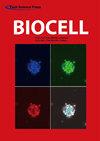Columbianetin acetate inhibits the occurrence and development of pancreatic cancer cells by down-regulating the expression of Meiotic nuclear divisions 1
IF 1
4区 生物学
Q4 BIOLOGY
引用次数: 0
Abstract
Columbianetin acetate (CE) is one of the effective components of Angelica pubescens. So far, the specific role and molecular mechanism of CE in pancreatic cancer are not clear. Thus, this study aimed to explore the specific mechanism of CE on pancreatic cancer. The target genes combined with CE were predicted through the PharmMapper database and the 3D molecular structure of CE. Then, the Cancer Genome Atlas (TCGA) and Cistrome data browser (DB) databases were used to screen Meiotic nuclear divisions 1 (MND1)-related genes, transcription factors, and transcription factor data sets, and the intersection of the above data sets. The “limma” package in the R and gene expression profiling interactive analysis (GEPIA) databases were used to analyze the correlation and survival difference between the target genes and MND1 to predict the degree of association between CE and MND1. Western blotting and RT-PCR experiments revealed the regulatory relationship among CE, E2F1, and MND1 at the cellular level. The specific effects of CE on pancreatic cancer cells were explored through CCK8, wound healing, migration, and flow cycle experiments. E2F1, also the predictive transcription factor of MND1, was also the predictive target protein of CE. At the same time, E2F1 and MND1 were closely related in pancreatic tissue. In the cell function experiment, CE and interference with E2F1 expression could reduce the gene and protein expression of MND1, which was closely associated with cell proliferation, migration, and cycle development. Similarly, interfering with the expression of mnd1 can also inhibit the further development of tumor cells. CE may inhibit the development of pancreatic cancer cells by reducing the expression of MND1. This implies that CE may be a potential novel agent for the treatment of pancreatic cancer.乙酸柱莲素通过下调减数分裂核分裂的表达抑制胰腺癌细胞的发生和发展
乙酸柱莲素是当归的有效成分之一。迄今为止,CE在胰腺癌中的具体作用和分子机制尚不清楚。因此,本研究旨在探讨CE治疗胰腺癌的具体机制。通过PharmMapper数据库和CE的三维分子结构预测与CE结合的靶基因。然后,利用Cancer Genome Atlas (TCGA)和Cistrome data browser (DB)数据库筛选MND1相关基因、转录因子、转录因子数据集以及上述数据集的交集。利用R和基因表达谱交互分析(GEPIA)数据库中的“limma”包分析靶基因与MND1的相关性和生存差异,预测CE与MND1的关联程度。Western blotting和RT-PCR实验揭示了CE、E2F1和MND1在细胞水平上的调控关系。通过CCK8、伤口愈合、迁移和血流循环实验探讨CE对胰腺癌细胞的特异性影响。E2F1也是MND1的预测转录因子,也是CE的预测靶蛋白。同时,E2F1与MND1在胰腺组织中密切相关。在细胞功能实验中,CE和干扰E2F1表达可降低与细胞增殖、迁移和周期发育密切相关的MND1基因和蛋白表达。同样,干扰mnd1的表达也可以抑制肿瘤细胞的进一步发展。CE可能通过降低MND1的表达来抑制胰腺癌细胞的发展。这表明CE可能是一种潜在的治疗胰腺癌的新型药物。
本文章由计算机程序翻译,如有差异,请以英文原文为准。
求助全文
约1分钟内获得全文
求助全文
来源期刊

Biocell
生物-生物学
CiteScore
1.50
自引率
16.70%
发文量
259
审稿时长
>12 weeks
期刊介绍:
BIOCELL welcomes Research articles and Review papers on structure, function and macromolecular organization of cells and cell components, focusing on cellular dynamics, motility and differentiation, particularly if related to cellular biochemistry, molecular biology, immunology, neurobiology, and on the suborganismal and organismal aspects of Vertebrate Reproduction and Development, Invertebrate Biology and Plant Biology.
 求助内容:
求助内容: 应助结果提醒方式:
应助结果提醒方式:


